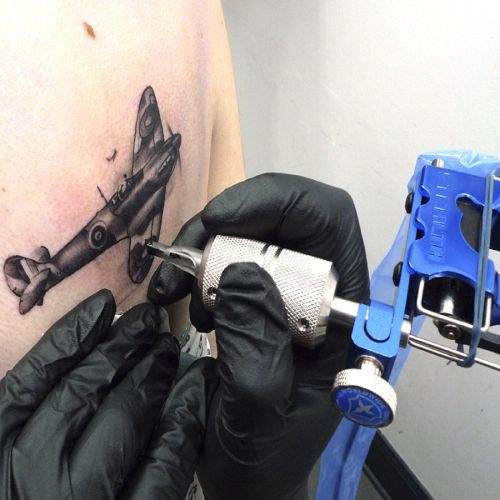Looking at the intricate tattoo designs of today, one might think that it would take such complicated equipment to create them. It’s interesting to note that, for more than a century, modern tattoos have actually been crafted using a small hand-held device first developed by one of the foremost scientific minds in history.
It was no less than the renowned American inventor Thomas Alva Edison who created what would become the basic tattoo machine in 1876. However, this initial invention (dubbed as Stencil-Pens) was actually intended to be used for embroidery. It wasn’t until 1891 when a New York-based tattoo artist named Samuel O’Reilly modified Edison’s invention for use in marking the human skin.

Tattoo Equipment
As such, there is some dispute as to who should really be credited for the tattoo machine’s creation. While Edison may have designed the mechanism, he originally built it for a different purpose. It was O’Reilly who further developed the technology and prepped it for its current function. Interestingly, the 1904 patent for the tattoo machine was held not by O’Reilly, but by his apprentice Charles Wagner.
The tattoo machine has seen further development throughout the years. A mere twenty days after the patent for the original tattoo machine was filed, a Thomas Riley from London, England patented his own variation, a single-coil tattoo machine constructed by modifying a door-bell assembly and placing it into a brass box. Alfred Charles South, also from London, would later patent his own two-coil design which would become the basis for modern tattoo equipment.
Unlike the Edison/O’Reilly Rotary tattoo machine, the Coil tattoo machine employed electromagnetic technology and for years was considered the more effective tool for tattooing. Two later classifications of tattoo machines were designed to perform specific functions. The first is the Liner tattoo machine, whose motor typically utilizes 8 wrap coils, and is used to draw the tattoo’s outlines. The other type is the Shader tattoo machine, which needs a stronger power supply to run its 10-wrap coil motor, and is used to fill in the outlines with color.
Even now, tattooing technology continues to advance. Among these is the Swash Drive, a bearing-driven modification of the Rotary tattoo machine. And then there’s the Pneuma, which foregoes the electromagnetism altogether and instead operates on air-compression. Modern tattoo devices have improved considerably in terms of speed and precision, so much so that new styles of tattooing have developed. Beyond the usual forms, there is now also Dermapigmentation, a method of applying tattoos as a permanent form of makeup, requiring the accuracy and meticulousness that only the best tattoo equipment can provide.
But even as modern tattoo equipment continues to be innovative, it still has its basis in that simple hand-held engraving machine made 134 years ago; an exciting mix of tradition and progress.
Jack also writes for http://www.tellmehowmuch.net/




